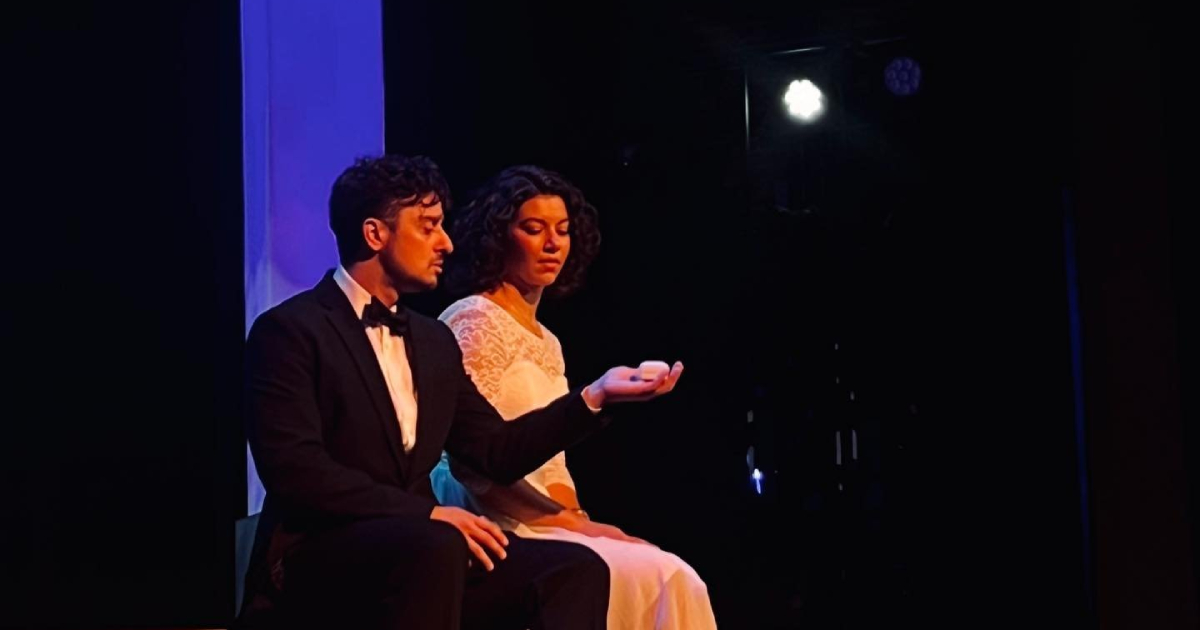The musical “The Last Five Years” is over before it really begins, much like an ill-fated relationship—particularly the five-year marriage at the center of this song cycle written and composed by Jason Robert Brown.
And that, in many ways, is what is most noteworthy about this show currently in production as Hope Repertory Theatre’s 52nd season opener—the way it experiments structurally with storytelling.
Directed by Rhett Luedtke with an effectively light touch, this 85-minute show is comprised of 14 songs, all solos, save but one duet in the middle. The two characters, New Yorkers Cathy Hiatt and Jamie Wellerstein, tell the story of their relationship in song. She opens the show at the end of the relationship with “Still Hurting” and he sings the next song, “Shiksa Goddess”, which speaks to the moment they met and fell in love. His solos move forward and hers move backward in time recalling the details and high valence moments of their lives and relationship together, most notably his enormous success as a writer and her struggle to find meaningful work as an actor, as well as her longing for him both emotionally and physically and his temptations and infidelity.
The show has had a cult following since it opened in Chicago in 2002 before moving to Off-Broadway and beyond, across the country and internationally. The music is mildly eclectic and pop-driven, drawing on influences as varied as Latin, Klezmer, blues, gospel, jazz, and classic show tunes, among others, and it is performed beautifully by the four-piece orchestra of strings and piano who play visibly upstage with music direction from Alex Thompson.
The songs are also sung powerfully by this small but mighty cast. Lea Sevola is an impassioned, intense, appealing Cathy with a depth of voice and convincing range of emotion that makes this sympathetic character and her feelings spring to life. The tension of this tale largely comes from her and her dissatisfactions with her relationship and her career. Highlights include her humorous “Climbing Uphill/Audition Sequence”, with Sondheim-esque stop-and-start inner workings that also have a nod to “A Chorus Line,” as well as “I Can Do Better Than That” in which she fully emerges as a dreamer, full of longing.
Michael G. Floriano strikes the right notes as an ambitious, clever, self-centered, largely unsympathetic Jamie. But that’s all primarily due to the way the character is writtenm and Floriano’s charm makes this Jamie notably not entirely unlikable, and his storytelling is top notch in songs such as “The Schmuel Song”, his gift to Cathie, and “Nobody Needs to Know”, his adultery song. And he and Sevola create gorgeous harmonies when they finally do sing together in “The Next Ten Minutes.”
In short, this is an excellent production of an interestingly flawed script. Technically, it keeps the focus on the story and characters with a simple set by Polly Robbins comprised of a couple tables and chairs, blankets and pillows, that are brought on and off a raised platform center stage by the actors, framed by five pylons lit from within (lighting design by Eric Van Tassell) as well as the on-stage orchestra. Subtle costume changes (costume design by Anna Hill) help signify mood as well as place and space, a crucial and helpful element in a show that deliberately scrambles the narrative.
That scrambled narrative is an intriguing conceit, though it largely creates more problems than it solves. With the plot revealed in reverse through each character that very rarely interact or even look at each other, developing character and complexity of relationship is an uphill battle. The trope of the woman waiting, always waiting, ever longing more deeply for the man who’s more interested in himself and his career than in the relationship is awfully tired. Many productions have played with casting actors of different races and ethnicities than written (though not HRT’s production); why not play with gender roles?
It’s hard to discern who, if anyone or anything, to root for in this tale. The relationship is DOA and therefore the drama of how it developed is diffused, and the characters are flawed, but not in a way that makes you fall in love with them. He’s clever and she’s sad, maybe a bit hopeless—until the very end, when she knows nothing of where she’s headed. But they certainly have a lot to say and sing it boldly. The music, performed magnificently by both the orchestra as well as the singers, may just be worth the cost of admission. Consider the experimental storytelling a bonus.
The Last Five Years
Hope Repertory Theatre
June 13-26
https://hope.edu/offices/hope-summer-repertory-theatre/on-stage/index.html





